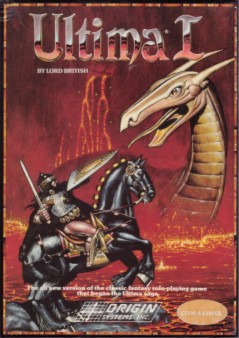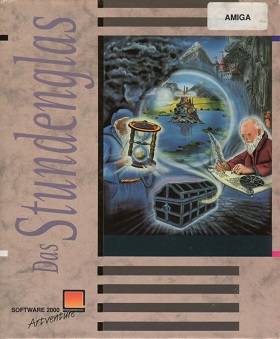Related Research Articles

Pool of Radiance is a role-playing video game developed and published by Strategic Simulations, Inc (SSI) in 1988. It was the first adaptation of TSR's Advanced Dungeons & Dragons (AD&D) fantasy role-playing game for home computers, becoming the first episode in a four-part series of D&D computer adventure games. The other games in the "Gold Box" series used the game engine pioneered in Pool of Radiance, as did later D&D titles such as the Neverwinter Nights online game. Pool of Radiance takes place in the Forgotten Realms fantasy setting, with the action centered in and around the port city of Phlan.
Heroes of Might and Magic, known as Might & Magic Heroes since 2011, is a series of video games originally created and developed by Jon Van Caneghem through New World Computing.

King's Quest is a graphic adventure game series, released between 1980 and 2016 and created by the American software company Sierra Entertainment. It is widely considered a classic series from the golden era of adventure games. Following the success of its first installments, the series was primarily responsible for building the reputation of Sierra. Roberta Williams, co-founder and former co-owner of Sierra, designed all of the King's Quest games until the series' reboot in 2015.

Pools of Darkness is a role-playing video game published by Strategic Simulations in 1991. The cover art and introduction screen shows a female drow. It is the fourth entry in the Pool of Radiance series of Gold Box games, and the story is a continuation of the events after Secret of the Silver Blades. The novel loosely based on the game was released in 1992. Like the previous games in the series, it is set in the Forgotten Realms, a campaign setting from Dungeons & Dragons. Players must stop an invasion from an evil god, eventually traveling to other dimensions to confront his lieutenants.

Septerra Core: Legacy of the Creator is a role-playing video game developed by Valkyrie Studios and published by Monolith Productions. It was originally released in 1999 for Windows; since then, it has been re-released via GOG.com for Windows in 2009, for OS X in 2013, and for Linux in 2017.

Ultima, later known as Ultima I: The First Age of Darkness or simply Ultima I, is the first game in the Ultima series of role-playing video games created by Richard Garriott, originally released for the Apple II. It was first published in the United States by California Pacific Computer Company, which registered a copyright for the game on September 2, 1980 and officially released it in June 1981. Since its release, the game has been completely re-coded and ported to many different platforms. The 1986 re-code of Ultima is the most commonly known and available version of the game.

Ultima IV: Quest of the Avatar, first released in 1985 for the Apple II, is the fourth in the series of Ultima role-playing video games. It is the first in the "Age of Enlightenment" trilogy, shifting the series from the hack and slash, dungeon crawl gameplay of its "Age of Darkness" predecessors towards an ethically-nuanced, story-driven approach. Ultima IV has a much larger game world than its predecessors, with an overworld map sixteen times the size of Ultima III and puzzle-filled dungeon rooms to explore. Ultima IV further advances the franchise with dialog improvements, new means of travel and exploration, and world interactivity.

King's Quest is an adventure game developed by Sierra On-Line and published originally for the IBM PCjr in 1984 and later for several other systems between 1984 and 1989. The game was originally titled King's Quest; the subtitle Quest for the Crown was added to the game box in the 1987 re-release, but did not appear in the game.

King's Quest II: Romancing the Throne is the second installment in the King's Quest series of graphic adventure games by Sierra On-Line. It was originally released in 1985 for PC DOS/PCjr, and later made available for the Apple II/IIGS, Atari ST, and Amiga. It uses the same AGI game engine as King's Quest I: Quest for the Crown and features King Graham as the player character. The title is a spoof of the 1984 film Romancing the Stone.

King's Quest III: To Heir Is Human is the third installment in the King's Quest series of graphic adventure games developed and released by Sierra On-Line in 1986. The game was originally released for the Apple II and PC DOS, and later ported to several other computer systems. It was the first title game in the series not to feature King Graham as the player character.

Quest for Glory: So You Want to Be a Hero is a 1989 adventure game/role-playing game hybrid, designed by Lori Ann Cole and published by Sierra On-Line for MS-DOS. It is the first game in the Quest for Glory series, and has been credited for being a genre-defining game, as it tried to mix graphical adventure gaming with role-playing-like elements such as statistic building that would actually affect the ability to accomplish certain parts of the game. The game has a satirical and silly tone. Ports for the Amiga, Atari ST, and NEC PC-9801 were released in the early 1990s. A VGA remake, titled Quest for Glory I: So You Want to Be a Hero, was released in 1992 for DOS and later in 1994 for Mac OS.

Space Quest III: The Pirates of Pestulon is a 1989 graphic adventure game by Sierra On-Line, and the third game in the Space Quest series.

Xak II: Rising of the Redmoon is a fantasy role-playing video game developed and published by the Japanese software developer MicroCabin. It is a direct sequel to Xak: The Art of Visual Stage. The game was released in Japan only, but due to an MSX scene that arose in Europe some of the MSX versions of Xak received fan translations. An enhanced remake was later released for the NEC PC-Engine, together with the first game in the series Xak as Xak I & II by Telenet Japan's development team Riot.

The Boggit: Bored Too is a text adventure game by Delta 4 released in 1986 for the Commodore 64, Amstrad CPC, and ZX Spectrum home computers. The game is a parody of the J. R. R. Tolkien novel The Hobbit and of the earlier game based upon it also called The Hobbit. It is the prequel to Bored of the Rings.
Dragon Quest is a series of role-playing video games that originated in 1986 with the release of the first game in the series. Although the games are not related in terms of story, many aspects of the gameplay are consistent throughout the series. Each game in the series add new elements to the gameplay, such as longer quests, character classes, or different ways of story-telling.

DragonFable is a free-to-play, online, browser-based, single-player, fantasy, role-playing game developed by Artix Entertainment and updated on a weekly basis. Players may access locked game content by upgrading to a premium account for a one-time fee.
There have been several King's Quest fangames both original and retellings/remakes of the original games that have been released by various developers.

Das Stundenglas is a German text adventure game published in 1990 by Software 2000 and developed by Weltenschmiede, and released for Amiga, Atari ST and DOS. Das Stundenglas is part of a text adventure trilogy; it is succeeded by Die Kathedrale (1991) and Hexuma (1992). The trilogy lacks an overarching plot, and in each entry the setting, role of the protagonist, and goal differ between each game. Games in the trilogy do not require knowledge of the other entries and may be played as standalone games.

Towers: Lord Baniff's Deceit is a first-person role-playing video game originally developed and published by JV Enterprises for the Atari ST in 1993. It is the first entry in the Towers series. In the game, players assume the role of adventurers tasked with finding Lord Baniff in his Tower, who has not been heard from by the people of Lamini. The title was later ported to both MS-DOS and Game Boy Color, each featuring various differences compared to the original release. It was met with mixed reception from critics across all platforms. A sequel, Towers II: Plight of the Stargazer, was released in 1995 for the Atari Falcon.
References
- ↑ "Kingdom O' Magic". Electronic Gaming Monthly . No. 83. Ziff Davis. June 1996. p. 93.
- ↑ Review of Kingdom O' Magic
- ↑ "Kingdom O' Magic (Remake)". Adventure Game Studio Forums. 2008.